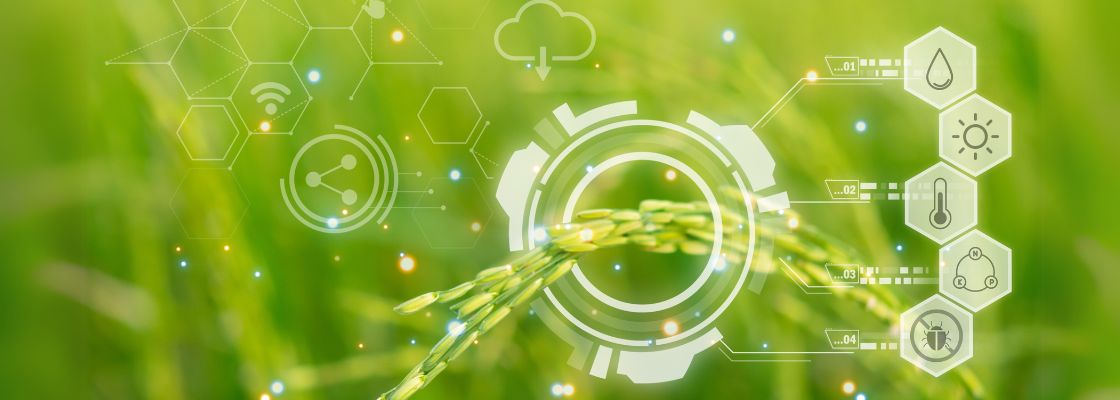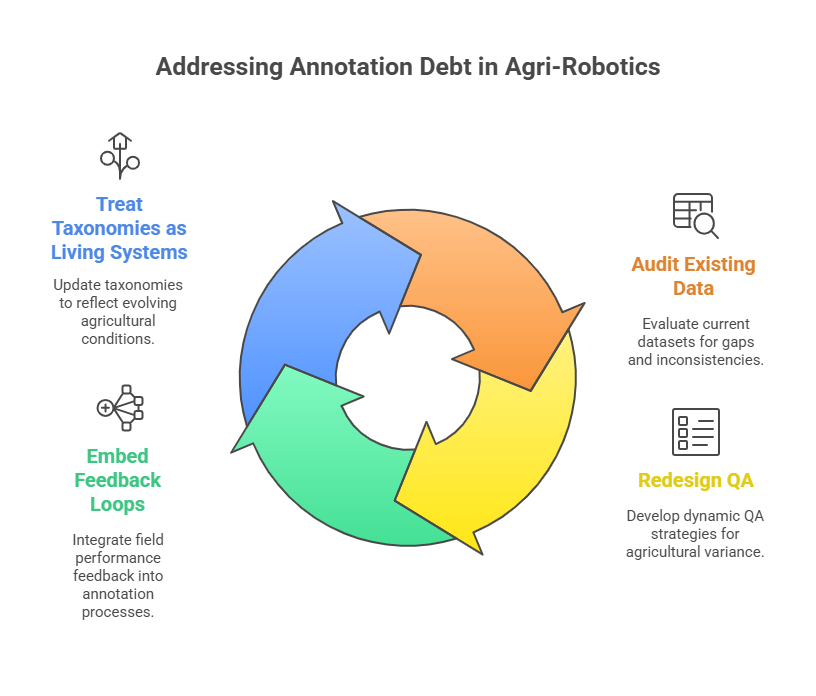Annotation Debt in Agri-Robotics: The Hidden Load Undermining Model Performance

A $2 million autonomous harvester sits idle in a California vineyard, its AI vision system convinced that perfectly ripe grapes are still weeks away from harvest. Meanwhile, 200 miles south, an identical machine is stripping unripe fruit, convinced it’s ready for processing. Same hardware, same software, but completely different outcomes because of a hidden problem most agri-tech teams don’t even know they have: annotation debt.
This scenario isn’t hypothetical—it’s happening across farms worldwide as AI-powered robotic systems rapidly expand into agriculture. From drones capturing multispectral crop imagery to autonomous machinery navigating fields with minimal human intervention, these innovations promise increased precision, reduced labor costs, and improved yields. But beneath this technological revolution lies an often-overlooked issue quietly sabotaging performance across the industry.
Much like technical debt in software development, annotation debt accumulates silently over time—becoming a performance drag on otherwise capable AI systems. And for agri-robotics, where environmental variability is constant and models rely heavily on accurate, evolving input data, this debt can quickly become the weak link that transforms cutting-edge technology into expensive farm equipment.
What is Annotation Debt?
Annotation debt is the build-up of inaccurate, outdated, inconsistent, or incomplete training data annotations. It results from tight production deadlines, static label taxonomies, inadequate QA protocols, or a lack of structured feedback between model predictions and annotation teams.
In agricultural AI models, especially those deployed in robotics, annotation debt surfaces as:
- Edge case misclassifications that go undetected
- Labels created using outdated taxonomies
- High relabeling rates after model deployment
- Sluggish retraining cycles due to unclear feedback loops
This debt doesn’t just slow your model—it distorts its understanding of the real world, leading to recurring errors, model drift, and, ultimately, loss of trust in automation.
The Cost of Ignoring It in Agri-Robotics
Precision farming environments are anything but static. Crops evolve, weather changes, and field conditions vary by season, region, and even time of day. Yet many AI pipelines still treat annotation as a one-time, manual task rather than a dynamic, evolving process.
The impact of poor annotations on robot vision performance can be severe:
- Crop Loss and Quality Degradation: Robotic harvesters misclassifying ripe versus unripe produce result in significant yield losses and reduced market value
- Resource Waste and Damage: Autonomous sprayers unable to distinguish weeds from crops due to poorly labeled multispectral data don’t just waste inputs—they can damage entire sections of farmland
- Operational Risk Escalation: These aren’t minor inefficiencies; they’re direct threats to your bottom line that compound across growing seasons
- System Reliability Breakdown: Performance inconsistencies erode farmer confidence in automation, leading to manual overrides that defeat the purpose of robotic systems
Moreover, fixing annotation quality issues in precision farming AI after deployment becomes exponentially more expensive. The longer annotation debt remains unchecked, the harder it becomes to trace back and correct the foundational errors embedded in the model’s training history. What starts as inconsistent labeling can snowball into complete model retraining across multiple growing seasons.
Signs Your Team is Accumulating Annotation Debt
If your agri-robotics pipeline is facing any of the following, annotation debt might be silently accumulating:
- Frequent re-labeling requests after inference
- High disagreement rates among annotators
- Model drift in new weather or terrain conditions
- QA teams overloaded with manual reviews
- Labels failing to reflect updated crop or field scenarios
- Performance degradation when deploying across different farms or regions
These are symptoms of a labeling pipeline that’s reactive, not adaptive—and in agri-robotics, where conditions change daily, that’s a critical vulnerability.

Cleaning Up Labeling Debt in Agri-Robotics Pipelines
Solving the problem requires treating annotations not as a back-office task, but as a core part of your AI development lifecycle. Here’s how to systematically address annotation debt:
1. Audit Your Existing Data:
Start by evaluating your current labeled datasets with agricultural variance in mind. Are edge cases like unusual weather conditions or crop diseases accurately covered? Are taxonomies still relevant across different growing seasons? Are annotations consistent across regions, farms, and equipment types?
A structured audit often reveals pockets of outdated logic, poor inter-annotator agreement, or label ambiguity—especially when dealing with robotic vision systems in complex, ever-changing agricultural environments.
2. Redesign QA to Match Agricultural Variance:
Most annotation QA systems operate on simple checklists or confidence thresholds. In agri-robotics, where sensor feeds are noisy and real-world variation is constant, this approach falls short.
Invest in QA frameworks that include dynamic sampling strategies, model-in-the-loop validation, and escalation protocols for low-confidence regions. Focus particularly on seasonal transitions, weather variations, and crop lifecycle stages where annotation errors are most likely to compound. These strategies not only reduce relabeling costs in agricultural robotics, but also create a scalable review structure that adapts to farming’s inherent variability.
3. Embed Feedback Loops from Production
Annotation workflows often operate in isolation from field performance. But your model’s mistakes in real farming conditions are your best data source for improvement. Implement pipelines that connect failed predictions back to annotation teams, enabling targeted relabeling and iterative improvement.
This shift ensures your data quality improves continuously—keeping pace with new inputs from autonomous machines, field sensors, and the natural evolution of crop conditions throughout growing seasons.
4. Treat Taxonomies as Living Systems
One of the leading causes of annotation debt in agriculture is rigid, outdated taxonomies that can’t adapt to farming’s dynamic nature. Static class structures may have worked for early model versions, but as your AI system encounters new varieties, growth stages, and environmental conditions, your label logic must evolve with it.
Introduce version-controlled taxonomies, ontology-aware QA tools, and context-specific labels that reflect real-world field conditions. Build in processes for regularly updating classifications based on seasonal learnings and regional variations.

The Strategic Payoff
Cleaning up annotation debt isn’t just about correcting past mistakes—it’s about future-proofing your AI investments in an industry where adaptation is survival. As agricultural models become more advanced and robotics platforms more autonomous, the cost of misalignment between your training data and field reality grows exponentially.
By prioritizing structured annotation practices, adaptive QA, and feedback-driven iteration, agri-tech teams can transform what was once a hidden bottleneck into a competitive advantage. Clean, adaptive training data becomes the foundation for reliable automation that farmers can trust with their most valuable assets.
Turn Challenges into Competitive Advantage
Agri-robotics is pushing the frontier of what’s possible in farming, promising solutions to labor shortages, sustainability challenges, and yield optimization. But no matter how advanced the hardware or sophisticated the algorithms, they’re only as reliable as the training data that shapes their understanding of the agricultural world.
Annotation debt affects agricultural AI models silently but severely. Left unchecked, it erodes model confidence, delays deployments, and leads to expensive rework that can derail entire automation initiatives. Tackling it now—with clear QA processes, feedback integration, and evolving taxonomies—ensures that your AI stays robust, adaptive, and ready to deliver on agriculture’s technological promise.
The choice is clear: address annotation debt proactively, or watch it slowly undermine the very innovation that’s supposed to transform farming.
V2Solutions has been providing high-quality data annotation, labeling, and verification services to leading agritech companies, helping them build adaptive AI systems that perform reliably across seasonal variations and field conditions. Connect with us to transform your annotation bottleneck into a competitive advantage and ensure your agricultural AI stays robust, scalable, and ready for real-world farming challenges.